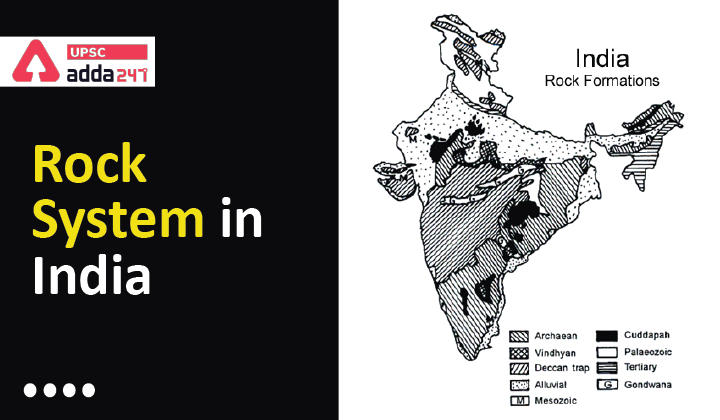Table of Contents
Indian Rock System
The geology of India is very diverse because rocks present in India belong to different geologic periods, dating as far back as the Eoarchean Era. While some of the rocks are deformed and altered, other deposits include recently deposited alluvium that has yet to undergo digenesis.
Major events in the geological history of India
- Peninsular India was a part of the old landmass since the formation of the Earth’s Crust/
- The upheaval of the Himalayas in the tertiary period.
- Aggradational formation of the Indo-Gangetic plain during the Pleistocene period, which continues till today through sedimentation in the floodplains of the rivers and the lower part of the Gangetic plain.
4 Major Rock systems in India
Based on this complex and varied geological history, the Geological Survey of India has classified the rock systems of the country into 4 major divisions:
- The Archaean Rock System
- The Purana Rock System
- The Dravidian Rock System
- The Aryan Rock System
The Archaean Rock System
- The term ‘Archaean’ refers to the oldest rocks of the earth crust.
- The earliest phase of tectonic evolution was marked by the cooling and solidification of the upper crust of the earth surface in the Archaean era.
- Due to magma solidification, they are devoid of any fossils.
- This rock system dates back prior to 2.5 billion years, which is also called Precambrian Period.
- It is represented by the exposure of gneisses and granites especially on the Peninsula.
- The rocks of the Archaean system are found mostly in Karnataka, Tamil Nadu, Andhra Pradesh, Madhya Pradesh, Orissa, Chotanagpur plateau in Jharkhand and the southern-eastern part of Rajasthan.
- They are found in the Aravalli hills, Deccan plateau and the northeast of India.
- They also occur in roots of the mountain peaks all along the Greater Himalayas, trans- Himalayan ranges of Zaskar, Ladakh and Karakoram.
- They serve as the basement complex or the foundation rocks for other rock systems which covers 2/3rd of Peninsular India.
- The Archaean group of rocks consists of two systems:
- Achaean System: Granites and Gneisses,
- Dharwar System: First Sedimentary Rocks
Dharwar system
- These rocks have been formed after the erosion and sedimentation of the rocks of the Archaean system.
- These are the oldest sedimentary rocks.
- The rocks of this system are economically very important. All the prominent metallic minerals like iron, gold, manganese etc are found in these rocks.
Purana rock system
- The Cuddapah and Vindhyan rock systems are together known as the Purana rock system.
- They are formed by the erosion and deposition of Archean and Dharwar rocks.
- These rocks are mostly sedimentary in nature.
Cuddapah system
- Named after the Cuddapah district of Andhra Pradesh, due to large development of outcrops of cudappah rocks.
- They were formed when sedimentary rocks like sandstone, limestone etc., and clay were deposited in synclinal folds (between two mountain ranges).
- These are famous for sandstone, limestone, and marble, asbestos.
Vindhyan System
- The system derives its name from the Vindhayan mountains.
- The system comprises of ancient sedimentary rocks (4000 m thick) superimposed on the Archaean base.
- This structure is famous for house-building rocks. The Sanchi Stupa, the Red Fort, the Jama Masjid etc are built with the red sandstone of this structure.
- It is devoid of metalliferous minerals but provides large quantities of durable stones, ornamental stones, limestone, pure glass making sand etc.
- The Vindhayan system have diamond bearing regions from which Panna and Golconda diamonds have been mined.





 TSPSC Group 1 Question Paper 2024, Downl...
TSPSC Group 1 Question Paper 2024, Downl...
 TSPSC Group 1 Answer key 2024 Out, Downl...
TSPSC Group 1 Answer key 2024 Out, Downl...
 UPSC Prelims 2024 Question Paper, Downlo...
UPSC Prelims 2024 Question Paper, Downlo...
